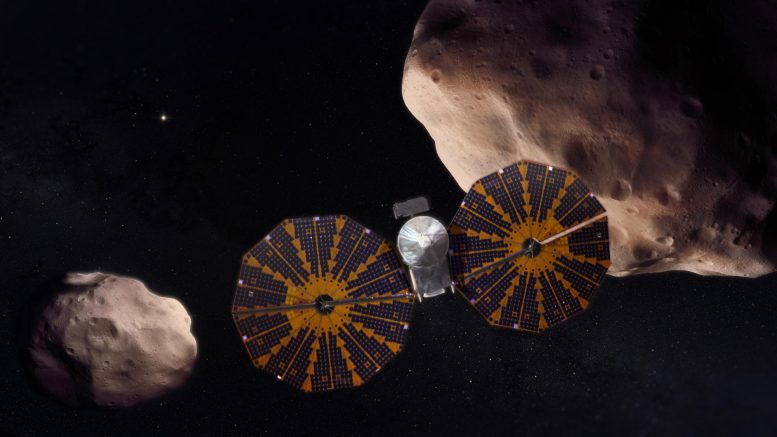
Η Λούσι θα εξερευνήσει τους Τρωικούς αστεροειδείς του Δία – που πιστεύεται ότι είναι «απολιθώματα σχηματισμού πλανητών». Πίστωση: Κέντρο Διαστημικών Πτήσεων Goddard της NASA
ακόμη και πριν από αυτό ελευθέρωση Τον Οκτώβριο του 2021,[{” attribute=””>NASA’s Lucy mission was already on course to break records by visiting more asteroids than any previous mission. Now, the mission can add one more asteroid to the list, after a surprise result from a long-running observation campaign.
Lucy’s science team discovered on March 27 that the smallest of the mission’s Trojan asteroid targets, Polymele, has a satellite of its own. On that day, Polymele was expected to pass in front of a star. This would allow the team to observe the star blink out as the asteroid briefly blocked, or occulted, it. The Lucy team planned to measure the location, size, and shape of Polymele with unprecedented precision while it was outlined by the star behind it. To do so, they spread 26 teams of professional and amateur astronomers across the path where the occultation would be visible.

A graphic showing the observed separation of asteroid Polymele from its discovered satellite. Credit: NASA’s Goddard Space Flight Center
These occultation campaigns have been enormously successful in the past, providing valuable information to the mission on its asteroid targets, but this day would hold a special bonus.
We were thrilled that 14 teams reported observing the star blink out as it passed behind the asteroid. However, as we analyzed the data, we saw that two of the observations were not like the others,” said Marc Buie, Lucy occultation science lead at the Southwest Research Institute, which is headquartered in San Antonio. “Those two observers detected an object around 200 km (about 124 miles) away from Polymele. It had to be a satellite.”

A graphic showing the observed separation of asteroid Polymele from its discovered satellite. Credit: NASA’s Goddard Space Flight Center
Using the occultation data, the scientists determined that this satellite is roughly 3 miles (5 km) in diameter, orbiting Polymele, which is itself around 17 miles (27 km) along its widest axis. The observed distance between the two bodies was approximately 125 miles (200 km).
Following planetary naming conventions, the satellite will not be issued an official name until the team can determine its orbit. As the satellite is too close to Polymele to be clearly seen by Earth-based or Earth-orbiting telescopes – without the help of a fortuitously positioned star – that determination will have to wait until Lucy approaches the asteroid in 2027, unless the team gets lucky with future occultation attempts before then.
At the time of the observation, Polymele was 480 million miles (770 million km) from Earth. Those distances are roughly equivalent to finding a quarter on a sidewalk in Los Angeles – while trying to spot it from a skyscraper thousands of miles away in Manhattan.

Using the occultation data, the team assessed that this satellite is roughly 3 miles (5 km) in diameter, orbiting Polymele, which is itself around 17 miles (27 km) along its widest axis. The observed distance between the two bodies was about 125 miles (200 km). Credit: NASA’s Goddard Space Flight Center
Asteroids hold vital clues to deciphering the history of the solar system – perhaps even the origins of life. Solving these mysteries is a high priority for NASA. The Lucy team originally planned to visit one main belt asteroid and six Trojan asteroids, a previously unexplored population of asteroids that lead and follow Jupiter in its orbit around the Sun. In January of 2021, the team used the Hubble Space Telescope to discover that one of the Trojan asteroids, Eurybates, has a small satellite. Now with this new satellite, Lucy is on track to visit nine asteroids on this remarkable 12-year voyage.
“Lucy’s tagline started out: 12 years, seven asteroids, one spacecraft,” said Lucy program scientist Tom Statler at NASA Headquarters in Washington. “We keep having to change the tagline for this mission, but that’s a good problem to have.”
Στις 9 Ιανουαρίου 2020, η αποστολή Lucy ανακοίνωσε επίσημα ότι θα επισκεφθεί όχι επτά, αλλά οκτώ αστεροειδείς. Όπως αποδεικνύεται, ο Eurybates, ένας από τους αστεροειδείς στο μονοπάτι της Lucy, έχει έναν μικρό δορυφόρο. Λίγο αφότου η ομάδα της Lucy ανακάλυψε τον δορυφόρο, αυτή και ο Eurybates κινήθηκαν πίσω από τον ήλιο, εμποδίζοντας την ομάδα να τον παρατηρήσει περαιτέρω. Ωστόσο, αστεροειδείς εμφανίστηκαν πίσω από τον ήλιο τον Ιούλιο του 2020 και από τότε, η ομάδα της Lucy μπόρεσε να παρατηρήσει τον δορυφόρο με το Hubble σε πολλές περιπτώσεις, επιτρέποντας στην ομάδα να προσδιορίσει με ακρίβεια την τροχιά του δορυφόρου και τελικά να επιτρέψει στον μικρό δορυφόρο να αποκτήσει πρόσβαση. Επίσημη ονομασία – Quetta.
Ο κύριος ερευνητής της Lucy εργάζεται στο Boulder του Κολοράντο, ένα παράρτημα του Southwest Research Institute, που εδρεύει στο Σαν Αντόνιο του Τέξας. Το Goddard Space Flight Center της NASA στο Greenbelt του Maryland, παρέχει ολοκληρωμένη διαχείριση αποστολών, μηχανική συστημάτων, ασφάλεια και διασφάλιση αποστολής. Η Lockheed Martin Space Corporation του Littleton του Κολοράντο κατασκεύασε το διαστημόπλοιο. Η Lucy είναι η δέκατη τρίτη αποστολή στο πρόγραμμα Discovery της NASA. Το Marshall Space Flight Center της NASA στο Huntsville της Αλαμπάμα, διαχειρίζεται το πρόγραμμα ανακάλυψης για τη Διεύθυνση Επιστημονικής Αποστολής του οργανισμού στην Ουάσιγκτον.

“Ερασιτέχνης διοργανωτής. Εξαιρετικά ταπεινός web maven. Ειδικός κοινωνικών μέσων Wannabe. Δημιουργός. Thinker.”


